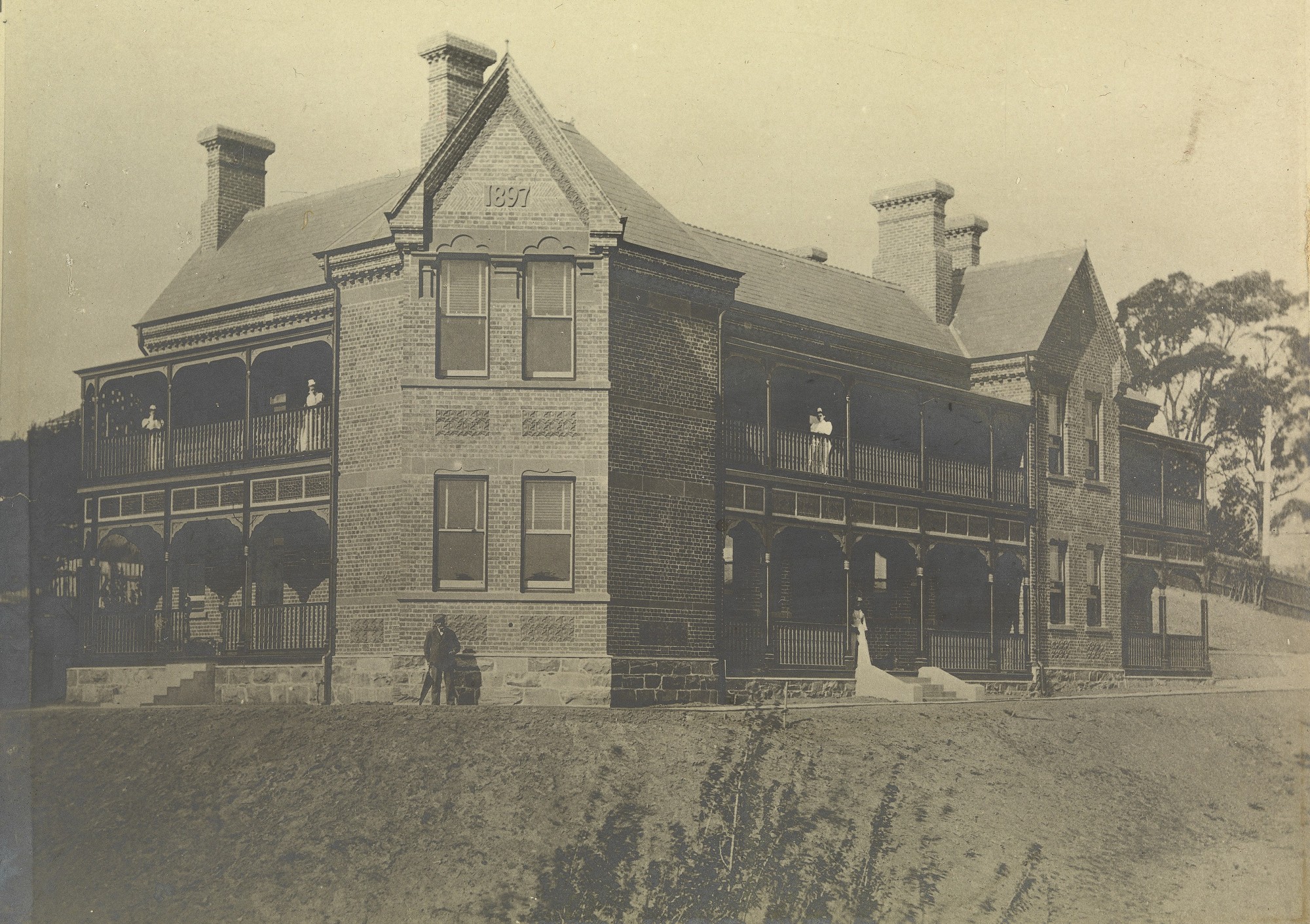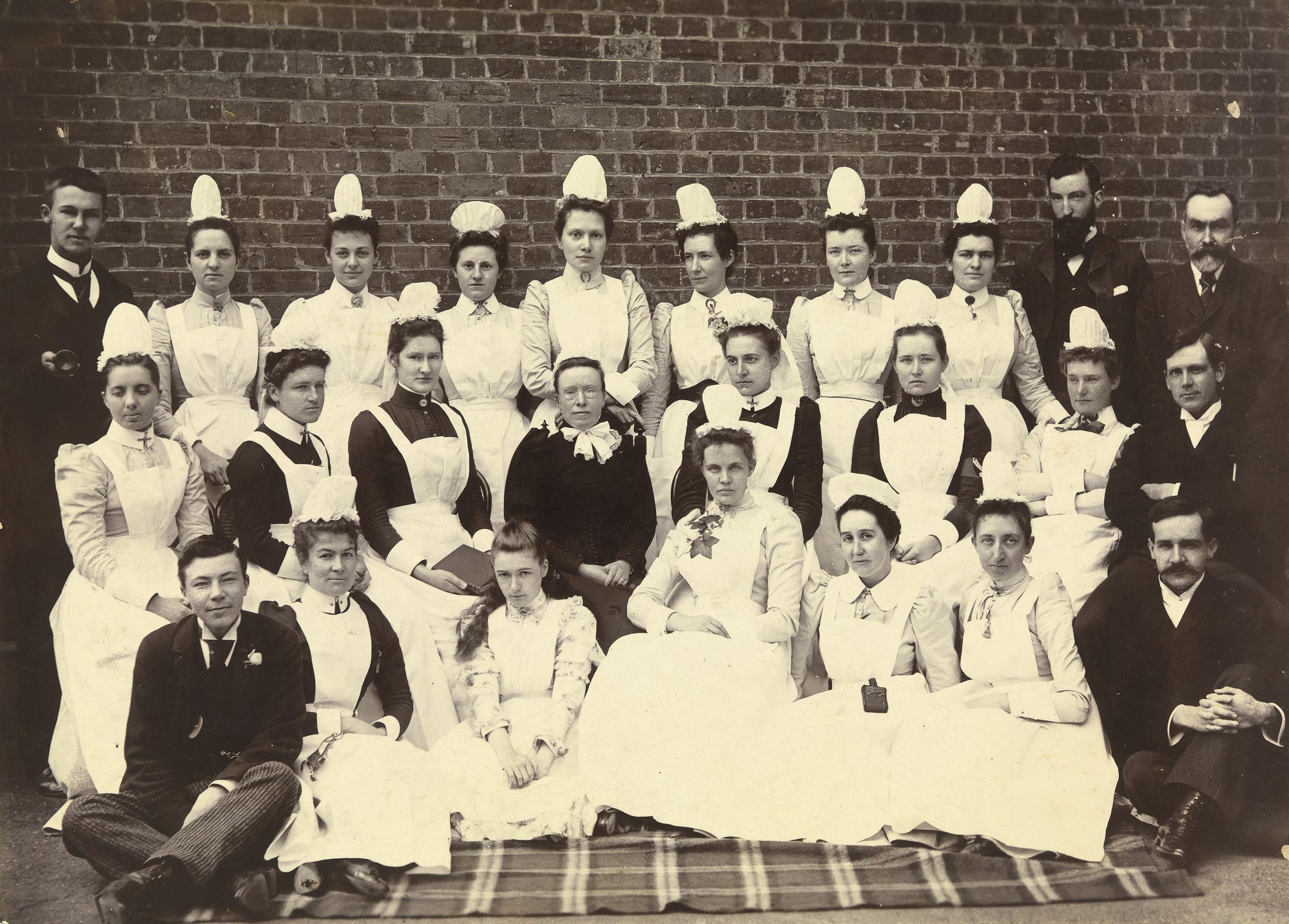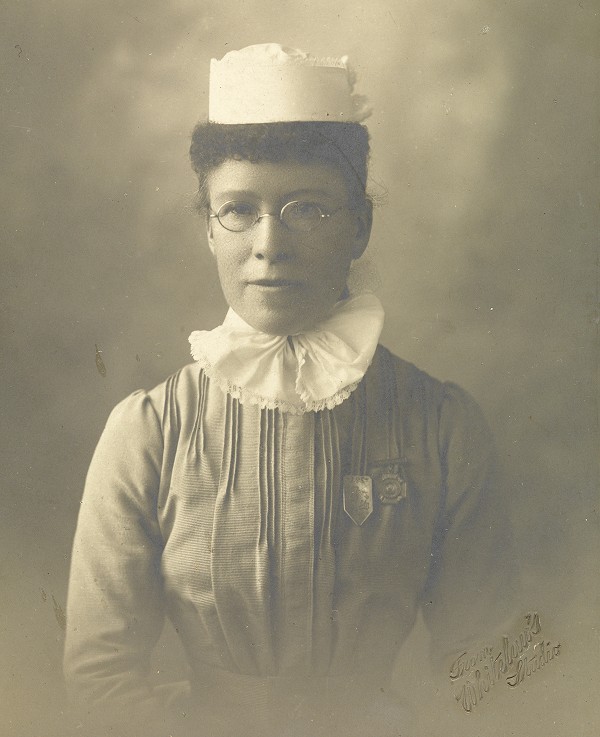Jeannette Milne
Photo from TAHO (Tasmanian Archive & Heritage Office), record, available Flickr
Jeanette Milne was a nurse from Edinburgh who came out to Australia during the time when the “Nightingale system” of nursing was still being introduced, hospital standards were generally poor and nurses rarely received formal training. (That’d be 1880s and later for most of Australia.) She was appointed matron at Launceston and established a training school for nurses. (It wasn’t just local nurses who were trained. Many of the WW I nurses that were supposedly Tasmanian turned out to have just done their training in Launceston for their training and then moved interstate to work.)
This next bit is extracts from a talk by Deanna Ellis for the Launceston General Hospital Historical Committee (in italics). The full talk is available in “Historical figures and their impact on medicine in Launceston : Dr Francis Drake, Miss Milne, Lady Superintendent, Dr William Prout Homan”.
Miss Milne’s exact birth date is unknown, it is thought to be 1853 as records show she was 24 years old in 1877 when she commenced nursing under Miss Pringle. Miss Pringle was a close friend of Florence Nightingale.
When Miss Milne entered the nursing profession the Register of the Royal Infirmary states that she lived at her stepfather‘s residence in Alford Aberdeen shire, was a domestic servant, single, aged 24 and commenced her nurse training on the 4th October 1877 completing her course on the 30th September 1878. Her training included experience in surgical and medical wards, the Fever House and one month with a private case. The record states that she was a very valuable nurse, thoughtful, thorough and kind, however her health was not very good having been ill and absent for two months. At the conclusion of her training she commenced the following day as a staff nurse on night duty in Ward 4M till July 1879 then was appointed charge of the ward on a day basis till it closed. She then worked as an extra nurse till being appointed charge of Ward 33.
After an appointment in England in September 1884, she left as one of a party of three to become sisters at the Government Hospital Hobart Town Tasmania in 1885. In 1886 she was appointed as Lady Superintendent of the Launceston General Hospital.

Launceston General Hospital (c1910)
Photo from TAHO (Tasmanian Archive & Heritage Office), record, available Flickr.
Five years after the opening of the Launceston General Hospital, the 1868 Hospital Annual report states: “that even though the best persons were selected to care for the sick they were poor substitutes for those who had been specifically trained for the purpose and a request for trained nurses was made to the Government.”
The first of these nurses to work at the LGH was Miss Troy, employed in 1879. The salary she received was the same as the male employees. 36 pounds and 10 shillings per annum. It was also recorded that a Matron was required and Miss Milne was the third Matron to be appointed, her predecessors being Miss Windred and Mrs. Wane. The 1889 Hospital Annual Report states that Miss Milne had put forward a proposal for lady pupils to be admitted to the Hospital to gain experience and a certificate in nursing.

Launceston General Hospital, Nurses Home
Photo from TAHO (Tasmanian Archive & Heritage Office), record, available Flickr
The following year the records show that she made a strong plea to the Board for a new nurses home, (this was built in 1897) and in the same minutes there were key statements related to the admission of lady nursing pupils and I quote:
“All candidates for admission to the Nursing Staff have now to sign articles of agreement binding them to serve as probationers for a term of two years. No candidate is required to sign such articles until after one month‟s probationary service. In consideration of their signing these articles the Board of Management, in addition to their receiving remuneration, take care that a regular system of training and instruction shall be given, and that on completion of the said two years, the Nurse shall be allowed to present herself for final examination and on receipt of a satisfactory certificate of proficiency shall be entitled to receive a formal certificate from the Board of Management.”
Miss Milne established the LGH Nursing School in 1890, delivering lectures along with the Surgeon Superintendent, the students were required to attend lectures in their own time and The length of training varied over the next 102 years. Initialing [sic] the training period was 2 years, extending to 3 and then reduced to 2 years during the war.
[end of Mrs Ellis’s talk]
In “Some Reminiscences of a Former Trainee”, Miss Oakes, who succeeded Milne, describes their first meeting as:
How well I remember my drive from from the railway station to the Hospital in a four wheeled cab, my nervousness increasing as I came nearer the Hospital. I was ushered straight into the office of the Matron, Miss Milne. It ws my first interview with her, as I had come over 1,000 miles from my home. Matron was quite pleasant, but Ithought looked severe. The only words I can recall of our interview were, ‘Nuss, you look very anaemic!’ I tried to answer bravely, “I am very strong, Matron,” but I had a sense of foreboding.

Jeanette Milne & Staff.
Photo from TAHO (Tasmanian Archive & Heritage Office), available Flickr
The Hospital Board have completed their regulations with regard to the course of study to be pursued by nurses. The object is to practically train ladies in the thorough nursing of the sick, and three sorts of certificates are provided for those who pass “with credit,” “with great credit,” and “with honour,” the latter to have a distinctive badge. Vacancies on the permanent staff will be filled up from those who pass, but the fact of holding a certificate or badge will be a sufficient guarantee to outside patrons that they are capable of undertaking the duties properly. There has been a great want of trained nurses in and around Launceston lately, and the committee, medical officers, and matron (Miss Milne), of the Institution are to be commended for their efforts towards supplying this.
The Mercury, 23 January 1892
HOSPITAL IMPROVEMENTS.
THE NURSES’ HOME.
The night nurses having taken up their quarters in the cottage purchased from Weymouth’s estate, a re-arrangement of the building which is now in use as a nurses’ home in the hospital grounds has taken place, which will materially add to the comfort of those whose arduous and trying duties render it necessary that their spare hours should be cheered by pleasant surroundings. The matron (Miss Milne) is now provided with a suite of apartments on the ground floor, a bedroom, sitting room, and office, with doors communicating between each apartment. The room opposite to this, which was formerly used as a bedroom, but was un fitted for such a purpose, has been converted into a fairly comfortable dining apartment, though not so cheerful as the one previously used as a dining and sitting room on the first floor, and which has now been converted into a bedroom. The nurses, however, have been provided with an additional sitting room, one of the apartments formerly assigned to the matron, and having a pleasant aspect, being fitted up for that purpose. On this floor a cosey little dining-room has also been provided for the wardsmaids. The night nurses have been given the front portion of Weymouth’s cottage, an arrangement which has long been desired. Until recently some of the nurses were provided with quarters outside the hospital grounds at a cost which will not now be necessary, whilst they will have the ad vantage of complete and undisturbed rest. Some of the wardsmaids are also provided for in the cottage, but their apartments are divided from those occupied by the night nurses by heavy doors, so that the main object–complete quiet–is not interfered with. The grounds have been put into fair order, though the work is not yet complete, and in time it is hoped that a large quantity of the vegetables required for the institution will be grown in the ample grounds surrounding the nurses’ home.
[continued]
Launceston Examiner. 23 November 1892
Matron Milne left the LGH in 1912 to become matron at the private hospital, St Margaret’s in Frederick St.
THE HOSPITAL MATRON.
PRESENTATION TO MISS MILNE.
Last night, at the Launceston Hospital, a very pleasing ceremony took place, when Miss J. H. Milne, the retiring lady superintendent, was the recipient of a purse of sovereigns.
In making the presentation Dr. Ramsay, the surgeon-superintendent, said it was an expression of the high esteem in which Miss Milne was held by all with whom she was associated in the institution. Miss Milne had never posed as a popular, matron. She was a strict disciplinarian, and always made the patients her first consideration in the training of her nurses, and no matron whose aim was loyalty to her work could please all whom that work concerned. Miss Milne had been 25 years in the position of matron of the Launceston hospital, and she had given her time, her skill, and her whole-hearted interest to the hospital. Miss Milne had worked under an avalanche of difficulties, for many of her first years at the hospital; a trained nurse was unheard of when she took charge. A “Sairey Gamp,” a couple of servants, and some men to attend the patients constituted the staff, and it was from such a primitive state of management that Miss Milne had evolved the splendid training school which now maintained. And it was entirely due to her splendid system that the nurses trained at the Launceston Hospital are wanted not only throughout the Commonwealth, but in all parts of the world. She was the original organiser of trained nurses in Tasmania. In handing the purse of sovereigns to Miss Milne, Dr. Ramsay said it was the gift of the past and present medical, nursing, nod domestic staff, and it carried with it every good wish for her future. In replying Miss Milne thanked all most heartily for the generous gift, which touched her deeply. She referred to the strict discipline a hospital nurse needed if she was to become a thorough nurse and of service in the profession she had chosen.
[continued]
Examiner, 1 May 1912
In 1928, she retired from St Margaret’s and went to live at St Helens on the east coast.
Matron J. Milne, who for many years was matron of the Launceston Public Hospital and later of St. Margaret’s Hospital, is seriously ill in the St. Helens Hospital. Her condition is causing her friends grave anxiety.
Examiner, 26 May 1933
DEATH OF MATRON MILNE
“Pioneer of Trained Nurses in Tasmania”
The death occurred at a private hospital, St Helens, on Saturday morning of Matron J. H. Milne, who since retiring from St. Margaret’s Hospital, Launceston, about three years ago, had lived at St. Helens with her niece, Miss L. Milne.
Matron of Public Hospital
Matron Milne was known to the profession as the “prisoner of trained nursing n Tasmania.” She came from Edinburgh, with Miss Rathie, an Edinburgh Royal Infirmary nurse, at the request of Dr. Smart, of Hobart, to institute proper training of nurses. Nurse Rathie later became matron of the Melbourne Hospital, and Miss Milne was appointed Matron of the Launceston Public Hospital at the time when the last Dr. K.H. Thompson was superintendent there.
She established the system of training nurses and very soon Launceston nurses held an excellent reputation for efficiency, not only among the doctors of this state, but everywhere on the mainland. In her endeavour to start a trained nurses’ association Matron Milne anticipated the formation of the Australasian Trained Nurses Association by about 20 years.
Appointed to St Margaret’s
After holding the position of matron at the Public Hospital for about 26 years, Miss Milne resigned to become matron of St. Margaret’s Private Hospital in 1912, and here the nursing staff under her direction was very quickly recognised to be one of outstanding efficiency.
In private life Miss Milne was esteemed by a very large circle of friends as one who was most sincere and always sympathetic. Her wide experience of life, and her dry humour made her a most interesting and entertaining conversationalist. Gardening was her hobby and at St. Helens she gave much time to it.
The funeral took place at St Helens yesterday afternoon, and was attended by a lage and representative gathering, including Doctors J. Ramsay, J.A. Newell, and W.P. Holman, of Launceston, Matron Oakes of St Margaret’s, and many of the nurses who trained under Matron Milne. Very deep sympathy is felt for Miss L. Milne, who is the only relative of deceased living in Tasmania.
Examiner, 29 May 1933
LATE MATRON MILNE
Tribute by Hospital Board
An impressive tribute was paid to the late Miss J. H. Milne by the chairman of the Launceston Public Hospital Board (Dr. J. Ramsay) at its meeting last night. In moving that the board record Its sympathy at Miss Milne’s death and its appreciation of her work, Dr. Ramsay said that she was Matron of the hospital for 26 years. She came to the institution in 1886. At that time there were a few untrained women nursing, and an equal number of wardsmen attending to the male patients. Matron Milne set about training those on the staff in the proper nursing methods she had acquired at the Edinburgh Royal Infirmary.
“She was engaged for the Hobart Public Hospital,” said Dr. Ramsay, “with another Edinburgh trained nurse, who was later matron of the Melbourne Hospital. Matron Milne came to the Launceston Public Hospital, and served under Drs. L. G. Thompson, Pardey, Drake, Parker, and myself.” Continuing, Dr. Ramsay said that Matron Milne had a fund of sympathy. She was firm, but always just. The nurses she turned out not only had an Australian but a world wide reputation. She left the Launceston Public Hospital to go to St. Margaret’s Hospital, and was a matron in Launceston for over 40 years, during which time she trained nurses no one could be ashamed of.
Dr. Ramsay stated that it was not intended this should be the only appreciation of Miss Milne’s services. A memorial fund, of which Miss Oakes, the present matron of St. Margaret’s, was secretary, was being instituted. The fund would be conducted with the aid of “The Examiner.” Mr. H. Weedon also spoke in appreciation of the services rendered by the late Miss Milne.
A MEMORIAL FUND
In connection with the proposed memorial the following circular, signed by Matron Oakes and Dr. Ramsay, has been Issued:–
“Many of the admirers of the professional services rendered to the community by the late Miss J. H. Milne consider that her memory should be perpetuated by some memorial in the Launceston Public Hospital or St. Margaret’s Private Hospital, or both. After her 27 years of service in the former hospital and 20 years in the latter in the capacity of matron, it is felt that the nurses trained under her excellent teaching and supervision, and the medical men who benefited by her professional skill and sympathy, may wish to contribute some thing towards this worthy object. She was the pioneer of trained nursing in Tasmania. The nurses trained by her have not only an Australian but a world-wide reputation. The nature of the memorial will be determined by the amount of the money subscribed. Subscriptions will be received by Miss Oakes, Matron, St. Margaret’s Private Hospital, Launceston.
“‘Signed on behalf of the committee,
“E. OAKES.
“J. RAMSAY, C.B.E.; M.S., F.R.A.C.S.”
Subscriptions may be sent to “The Examiner” office, and will be forwarded to Miss Oakes for acknowledgment.
Examiner, 9 June 1933
A letter was received from the trustees of the Milne Memorial Fund, enclosing a bank pass-book with a balance of £99 3s 2d. It was stated that a die for a medal had been struck, and that the interest on the amount of the fund was to he used for the purpose of purchasing each year the Milne Memorial Medal to be awarded in the Launceston Public Hospital for practical nursing.
Examiner, 14 February 1936
Headstone in St Helens General Cemetery (under M)
Will
(Trove entry for the LGH Historical Committee conference paper, in case the Stors link disappears, as they sometimes do.

